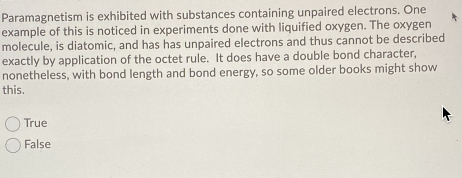Paramagnetism is exhibited with substances containing unpaired electrons. Uhe example of this is noticed in experiments done with liquified oxygen. The oxygen molecule, is diatomic, and has has unpaired electrons and thus cannot be described exactly by application of the octet rule. It does have a double bond character, nonetheless, with bond length and bond energy, so some older books might show this. True False
Paramagnetism is exhibited with substances containing unpaired electrons. Uhe example of this is noticed in experiments done with liquified oxygen. The oxygen molecule, is diatomic, and has has unpaired electrons and thus cannot be described exactly by application of the octet rule. It does have a double bond character, nonetheless, with bond length and bond energy, so some older books might show this. True False
Principles of Modern Chemistry
8th Edition
ISBN:9781305079113
Author:David W. Oxtoby, H. Pat Gillis, Laurie J. Butler
Publisher:David W. Oxtoby, H. Pat Gillis, Laurie J. Butler
Chapter3: Atomic Shells And Classical Models Of Chemical Bonding
Section: Chapter Questions
Problem 101AP: (a) Predict the geometry of the SbCl52 ion, using the VSEPR method. (b) The ion SbCl63 is prepared...
Related questions
Question
Chem Help

Transcribed Image Text:Paramagnetism is exhibited with substances containing unpaired electrons. One
example of this is noticed in experiments done with liquified oxygen. The oxygen
molecule, is diatomic, and has has unpaired electrons and thus cannot be described
exactly by application of the octet rule. It does have a double bond character,
nonetheless, with bond length and bond energy, so some older books might show
this.
True
False
Expert Solution
This question has been solved!
Explore an expertly crafted, step-by-step solution for a thorough understanding of key concepts.
Step by step
Solved in 2 steps with 1 images

Knowledge Booster
Learn more about
Need a deep-dive on the concept behind this application? Look no further. Learn more about this topic, chemistry and related others by exploring similar questions and additional content below.Recommended textbooks for you

Principles of Modern Chemistry
Chemistry
ISBN:
9781305079113
Author:
David W. Oxtoby, H. Pat Gillis, Laurie J. Butler
Publisher:
Cengage Learning

Chemistry: The Molecular Science
Chemistry
ISBN:
9781285199047
Author:
John W. Moore, Conrad L. Stanitski
Publisher:
Cengage Learning

Chemistry: Principles and Practice
Chemistry
ISBN:
9780534420123
Author:
Daniel L. Reger, Scott R. Goode, David W. Ball, Edward Mercer
Publisher:
Cengage Learning

Principles of Modern Chemistry
Chemistry
ISBN:
9781305079113
Author:
David W. Oxtoby, H. Pat Gillis, Laurie J. Butler
Publisher:
Cengage Learning

Chemistry: The Molecular Science
Chemistry
ISBN:
9781285199047
Author:
John W. Moore, Conrad L. Stanitski
Publisher:
Cengage Learning

Chemistry: Principles and Practice
Chemistry
ISBN:
9780534420123
Author:
Daniel L. Reger, Scott R. Goode, David W. Ball, Edward Mercer
Publisher:
Cengage Learning

World of Chemistry, 3rd edition
Chemistry
ISBN:
9781133109655
Author:
Steven S. Zumdahl, Susan L. Zumdahl, Donald J. DeCoste
Publisher:
Brooks / Cole / Cengage Learning

Introductory Chemistry: A Foundation
Chemistry
ISBN:
9781337399425
Author:
Steven S. Zumdahl, Donald J. DeCoste
Publisher:
Cengage Learning

Chemistry for Engineering Students
Chemistry
ISBN:
9781337398909
Author:
Lawrence S. Brown, Tom Holme
Publisher:
Cengage Learning